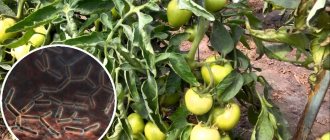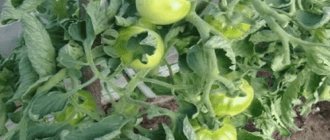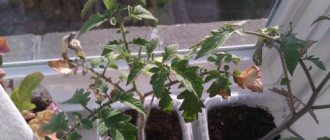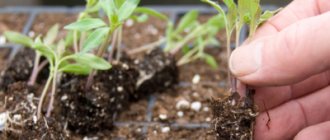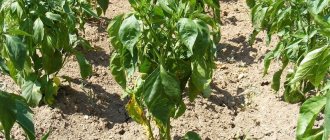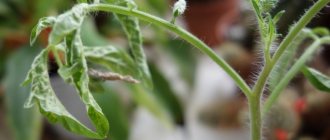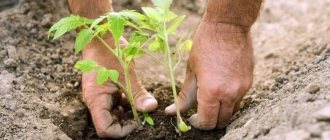How and when to pick tomato leaves in a greenhouse
When growing tomato plants in a greenhouse and open ground, work on the formation of bushes is assumed.
This measure is necessary to improve the growth of tomatoes and the ripening of their fruits. As a rule, you need to tear off excess leaves and shoots of tomato, which are called stepsons. They only increase the amount of green mass on the bushes and consume the nutrients necessary for ripening tomatoes. If you neglect this measure, the tomato fruits will grow small, the plants will get sick, and the quality of the harvest will be low.
The need to remove leaves from tomatoes
It is no secret that the foliage of any plant performs important functions of photosynthesis. And if you tear off all the leaves from a bush, it will simply die.
During the growth process, the very first leaves located below begin to age, come into contact with the surface of the soil, turn yellow and become covered with spots. They are the ones who provoke air stagnation in the greenhouse and the development of diseases . If you think about it, they have fulfilled their function, the plant no longer needs them.
During the growth process, the first leaves that appear begin to age and need to be removed.
Which leaves on tomatoes need to be trimmed?
It is not recommended that when you come to your garden, you cut off everything that the eye can see. The bushes are alive and experience stress from any action. So you should not remove a large number of leaves .
First of all, you need to break off the greenery that lies on the ground . After a few days, you can examine the plants more carefully, and if the tomatoes on the cluster have grown to normal size, you can safely remove the foliage located below.
As a rule, experienced gardeners perform a similar procedure twice a week , which allows the plant to form fruits in the clusters located higher.
In addition, you should pay attention to:
- north-facing foliage. This will improve the ventilation of tomato beds, which is very important for dense plantings;
- fatliquoring branches that do not form fruits. By removing them, you will enable the bush to increase its yield.
If fruits do not form on the branches, they need to be removed
Correct timing for pruning leaves
Some gardeners begin removing the lower foliage as soon as the fruit cluster begins to bloom . A separate category states that this should be done after the tomatoes are formed .
Based on theory, during the period of flowering and ovary formation, tomato brushes receive the necessary nutritional components formed as a result of photosynthesis directly from the leaves. A little later, as soon as the tomatoes begin to synthesize them on their own, the leaves can be trimmed.
It is impossible to determine specific deadlines for this . Much depends on the type of crop, the climate in a particular area, and the greenhouse microclimate. It is necessary to take the period of flowering and fruit appearance as a guide. As soon as the vegetables begin to increase in size and turn brown, the lower leaves should be removed gradually.
In a normally developed bush, the thirty-centimeter part of the stem under the lower fruit cluster should be empty . Only in this case will it receive the required amount of light, and nutrients from the root system will flow directly to the ripening tomatoes.
In a normally developed bush, 30 cm of the lower stem has no leaves
Feel free to add to this an increase in air humidity, improved ventilation, and a reduced risk of disease.
How many brushes should I leave on tomatoes in the greenhouse?
At the end of July - beginning of August, most gardeners begin pinching the tops of plants. It is already becoming obvious that the remaining brushes will not have time to form tomatoes. Seven to eight of the most developed tassels remain on the plant , which will produce the harvest.
After such a procedure, when you don’t need to grow any greenery, you can trim all the foliage , leaving three or four on top. Firstly, you will not disrupt the movement of sap through the plant. Secondly, take excellent preventative measures against possible diseases.
As you can see, this measure is really necessary; it helps the plant grow and bear fruit very well. By following all the recommendations, you can protect your beds from disease damage and get a decent harvest of tomatoes.
The main thing is to carefully examine the bushes, choose the right foliage to remove, and act carefully so as not to injure the crop.
What are green operations?
Green manipulations with an adult bush are the formation of a culture.
Scheme of tomato bush formation.
It involves the following procedures:
- removal of stepsons;
- pruning foliage;
- pinching the top of the plant.
Each such operation pursues specific goals.
Do I need to remove leaves from tomato bushes?
Growing this crop in greenhouse or outdoor conditions involves carrying out work on the formation of shrubs. The need for the procedure is to improve the growth of tomatoes and ensure good ripening of the crop. Most often, excess foliage is torn off from bushes, as well as part of the shoots called stepsons. Both of them only increase the amount of greenery and waste the nutrients needed for fruit ripening.
If you do not remove excess foliage, the harvest will be small, the bushes will often get sick, and the quality of the tomatoes will not be the best.
If the variety is unknown
It happens that a vegetable grower, having planted a greenhouse, does not know how the variety behaves (tall or short). In this case, you should monitor the plant.
- Tall varieties lay flower sours after 9–11 leaves , and some even after 13 .
- Determinate varieties begin to form a brush after the 6th leaf. Using this principle, you can “sense” the direction of the planted plant and begin pinching or do without such a process.
It is very important that the procedures of pinching, pinching and removing foliage are carried out in a timely manner.
The result of competent implementation of “green operations” will be a good harvest.
Each delay takes away nutrients that can be successfully used to grow a marketable fruit.
The need to remove leaves from tomatoes
The leaves of each plant are involved in the most important process of photosynthesis, and if all the green mass is removed, the crop will simply die.
As tomatoes grow, the green parts located below gradually age, begin to come into contact with the ground, change color and become stained. Because of them, air masses stagnate (when grown in greenhouse conditions), and some ailments also develop. In fact, the function assigned specifically to these leaves has already been completed, and now they are no longer needed.
In the greenhouse
If you carefully examine tomatoes growing in a greenhouse, you can determine the need to trim the leaves. The presence of heavily overgrown bushes signals that you can start plucking the foliage. As for any specific features of removing excess vegetative mass, they do not exist, but experienced gardeners recommend doing this procedure once every 7 to 14 days.
- dried and black leaves;
- leaves with brown-brown, black dots and spots;
- vegetative mass that interferes with air exchange processes in shrubs;
- lateral shoots appearing between the base of leaves and stems;
- outer foliage appearing in fruit clusters;
- old leaves in contact with the ground.
In the open ground
If the crop is grown in an open bed, then due to exposure to ultraviolet rays, the vegetative parts of the plant undergo normal development of tomatoes. Excessive thickening of bushes leads to the fact that the amount of harvest invariably decreases, because everyone no longer has enough sunlight.
Tomatoes planted close to each other develop a deficiency of nutritional components; in addition, there is an increased formation of moisture, which is also not a very good indicator. To prevent all this, timely removal of excess green mass is carried out.
The soil is an ideal environment for most harmful organisms; it will not be difficult for them to climb onto the lower leaves of tomatoes and then spread throughout the plant. Of course, there are special preparations that allow pest control, but then it will be difficult to classify the harvest as environmentally friendly. An excellent preventative procedure is to remove the lower leaves.
Stages of crown formation
The crown of a tomato bush is formed in several stages:
- Stepsonning.
- Pinching the top.
- Removing leaves.
A properly formed bush will always give a greater harvest
It is important to carry out all these stages on time, preventing the bush from growing. The greenhouse grower's task is to remove all unnecessary greenery and direct the beneficial substances coming from the tomato stems, leaves and roots directly to the fruit cluster
Stepsoning
Tomatoes can be grown with one or two or three stems. If you decide to leave only the central stem, all lateral ones must be destroyed. If there are several, then it is worth leaving for fruiting those stepsons that are closest to the main cluster with fruits. A bush with a total of no more than three stems and eight brushes is considered ideal.
The stepsons are removed with a sharp knife or simply with your hands. The main thing is not to damage the main stem.
Stepchildren are carried out as the stepsons grow; it is desirable that they are less than 5-8 cm in height, but have already formed a stem. It is necessary to regularly inspect the tomato bushes in the greenhouse (every 10-12 days), cutting off the side stems. It is better to remove stepsons in the morning with a sharp knife or even a fingernail, without damaging the main stem.
You cannot break off the entire stepson, otherwise a new one will grow in its place after a while. To prevent this from happening, you need to leave a piece of the stem - a stump 2-3 mm long.
Pinching the top, or topping
Topping is done for the same reason as pinching. When the bush is already formed and a sufficient number of clusters form fruits, you need to stop the growth of the main stem. Throughout the growing season, it stretches upward, producing more and more new shoots and ovaries.
Topping a tomato bush
As a rule, the procedure for pinching the top falls in the middle or end of July. The top of the stem is cut with a sharp knife at the level of the third or fourth leaf above the ovary; two or three leaves should remain for the full development of the fruit.
Important! Trimming the top will stop unnecessary growth of the bush so that the plant can devote all its strength to ripening the already formed tomatoes.
Removing leaves
When the fruits on the tomatoes in the greenhouse have already set and grown, the process of their ripening begins. From green they first become whitish, then brown, and only then acquire their final color
It is believed that during the period of fruit ripening, leaves no longer play an important role. On the contrary, they weaken the plant, taking away some of the beneficial substances destined for the brushes.
It is especially important to remove the lower leaves, as by this time they turn yellow and curl. Greenhouse growers have differing opinions on this matter.
Some vegetable growers believe that it is necessary to remove all leaves except the very top ones, others argue that leaves are actively involved in the process of photosynthesis, so only diseased leaves and those that shade the fruits are removed.
Scheme: formation of a tomato bush
Leaves must be removed with extreme caution, otherwise gray rot may appear at the cut site. To prevent this from happening, it is better to do the work in the first half of the day in sunny weather.
In this case, by evening the sections will have time to dry. You can go the other way, lubricating each cut with a disinfectant solution to prevent the development of the disease.
For this, 2 tbsp. fluff lime is mixed with 1 tbsp. copper sulfate, and then diluted with water to a liquid slurry. This procedure is required if pruning leaves is done in damp or cloudy weather.
Pruning tomatoes in a greenhouse video
To gain more insight into proper pruning, especially for beginners, it is helpful to watch the video.
What leaves need to be trimmed from tomatoes?
It is not worth cutting off all the green mass of a plant in a row. Shrubs are living, and such actions lead to stress. There is no need to remove large quantities of foliage in one step.
Initially, all greenery lying on the ground is removed. After a couple of days, it is recommended to inspect the tomatoes and, if the tomatoes on the tassels have acquired normal sizes for the variety, trim the foliage located below.
Most gardeners remove green mass twice a week. Thanks to this, shrubs can form tomatoes in tassels located higher.
In addition to the above, it is worth paying attention to some points:
- foliage facing north, when removed, air exchange in the beds improves, and this is an important point when planting thickly;
- empty branches on which fruit formation does not occur. By removing them, the productivity of the bush can be increased.
Types of pinching
There are several types of pinching, which differ in the amount left during the removal of excess shoots and branches. Each of these types has its own characteristics, which will be discussed in more detail below.
In one stem
The method of forming into one stem is excellent for bushes grown in a greenhouse. In this case, there will be no extra branches thickening the plants, which will provide them with good ventilation and sufficient light.
Immediately after the stepson begins to grow under the first formed brush, it should be cut off. At the same time, the lower leaf plates are also torn off from the bushes, which only hinder them at this stage of development. Next, carry out a systematic inspection of the bushes and cut off all emerging side shoots, while flowering brushes must be left behind.
Thanks to this method of forming a bush, about 50 brushes can grow on it, on which fruits will form. This method also allows you to extend the fruiting period.
In two stems
Forming a bush into two stems is also well suited for greenhouse tomatoes. In this case, you need to leave only one most powerful stepson, which grew under the first flowering brush. Those side shoots, as well as leaf plates that are located below this stepson, must be torn off. In the future, systematically inspect the bushes and cut off all excess shoots.
Three stems
Bushes formed into three stems are most suitable for growing in open ground, but not for a greenhouse. To form a plant into three stems, you need to cut off all the side shoots except two. The first stepson should be under the first flowering brush, and the second one should be above it. Next, the tomatoes are regularly inspected and excess shoots are removed.
How to properly prune tomatoes
There are no strict instructions that must be carefully followed when carrying out this procedure. It is worth focusing on the fact that the plant will calmly tolerate the removal of up to three leaves twice every 7 days. More global pruning is needed only if there is a dangerous disease developing on the shrub.
How to trim shoots
There are various methods for removing foliage, but it is recommended to choose the one that is most convenient for humans and the least harmful to the tomato crop.
Breaking off the foliage with a slight turn of the stem clockwise is a more humane procedure, but it cannot be called ideal. It is best to use scissors or pruning shears for pruning. Instruments must undergo a disinfection procedure before use.
Leaf trimming procedure
Advice from gardeners
Experienced gardeners recommend the following:
- The best time for pruning is morning. The reasons have been described above.
- When pruning the stepsons, you do not need to completely remove the shoot; you should leave a small stump 1-1.5 cm in length. This is necessary in order for the damaged area to dry and heal. When cutting the stepson, the stem tissues are completely damaged, and this has a negative impact on the further development of the entire shrub.
- Greenhouse tomatoes are pruned every 9–11 days. This time is enough for the shoot to grow to the desired size, which reduces the likelihood of accidentally removing the fruiting cluster. Removal of stepsons occurs when they reach 5–6 centimeters in length.
- It is recommended to monitor the appearance of dry and yellow leaves - they are removed immediately. Otherwise, the plant will waste useful elements to maintain the life of unnecessary larch mass. It is recommended to treat the area where the cut was made with a disinfectant. A simple procedure will help prevent harmful microorganisms from entering the “wound”. Working equipment is processed after each tomato to prevent the spread of any diseases.
- As soon as the first fruiting cluster blooms, cut off all the foliage below. This applies specifically to the first flowering. An adult plant should have a bare stem part at a height of up to 30 cm from the ground.
When and how to pluck the lower leaves of tomatoes in a greenhouse - pruning diagram
Three main questions worry gardeners, especially beginners, all summer. How, why and when to pick leaves from tomatoes in a greenhouse. And what kind of leaves are they? Yes, for some beginners, caring for greenhouse tomatoes is a dark forest. And sometimes such a dark forest stands in greenhouses. For example, my neighbor literally crawls into hers on all fours, although she has a large six-meter polycarbonate greenhouse.
Some people feel sorry for plucking something unnecessary from a bush, or they are afraid that they will do something wrong. So the poor things stand in the dark thicket and the bushes turn out to be weak, and the harvest suffers, and so many diseases appear. After all, the most common fungal diseases of tomatoes just like it to be humid, not ventilated, and have a place to multiply. They choose, of course, the convenient lower leaves of the tomato. And then you worry about why the leaves started to turn yellow, black, and brown.
Mistakes gardeners make when planting
Incorrectly carried out pinching can create additional problems for the gardener. Let's look at the main mistakes that are made during this procedure:
- Erroneously deleting the wrong shoot.
In young plants, it is not always possible to determine which of the shoots is the main one, and the gardener may mistakenly cut off the wrong stem. If you doubt whether he is really a stepson, it is better to wait until he is a little older to be sure.
- The blades of scissors should be as sharp as possible.
A blunt instrument can seriously injure the plant, since it is not always possible to cut a branch the first time.
- It is advisable to wipe the scissors with a disinfectant solution, at least the same potassium permanganate, during the pinching process after processing each bush. Those who neglect this rule can easily transfer the infection from a diseased bush to other plants, spreading it throughout the greenhouse.
- Some people cut off the shoot at the root; as a result, after a while a new shoot grows in the same place. The stump left should not be shorter than 1.5 cm.
- Leaving cut shoots inside the greenhouse can cause an outbreak of infection. After the procedure, all branches must be removed.
- Beginners can start planting standard tomatoes, but this is wrong. In such varieties, stepsons are able to form, but their further growth does not occur and this does not affect fruiting in any way. It is not customary to plant standard tomatoes.
Anyone who grows tomatoes in a greenhouse needs to know not only what varieties are shaped and how, but also do it in compliance with all the details. Over time, any summer resident will gain the necessary experience and will be able to get by without the help of tips. A beginner simply needs to study all the recommendations so as not to be disappointed in the fruits of his labor and get the long-awaited magnificent harvest of his own tomatoes.
Why and when to pick leaves from tomatoes in a greenhouse
As you know, leaves of any plant have a very important function of photosynthesis. The leaf is a very important part of the plant; if, for the sake of an experiment, you peel off all the leaves on the bush, the plant will die. But gradually, as the bush grows, the very first lower leaves become old, usually they lie or touch the ground, become yellow or spotted.
These leaves provoke air stagnation in the greenhouse and the development of diseases. In fact, they have fulfilled their function and are no longer needed by the plant.
You can’t immediately rush mindlessly into the garden and cut off everything you see in armfuls. The plant is alive and it always experiences stress during any manipulation of its crown. Therefore, you cannot remove many leaves at one time.
When should you start pruning? Here look at the tomato bunches; if all the tomatoes above the leaves in the bunch have grown to more or less standard sizes, feel free to remove the leaves. Do not leave anything underneath such a brush.
Typically, experienced gardeners do pruning twice a week, just in time for fruit to set in the next higher clusters.
How to properly remove leaves from tomatoes in a greenhouse
Breaking, deleting, trimming, everyone does it differently. It is better to choose the method that will harm the plant the least and is more convenient for you.
You cannot abruptly tear off the leaves by pulling them down; you get a very large wound on the tomato, in which bacteria can quickly grow.
Some break out the leaves and stepsons, turning them slightly clockwise, you can do this too. When I go to the greenhouse, I arm myself with scissors and a jar of hydrogen peroxide. Trimming with scissors is much faster and more convenient, and it is also easier to treat them with peroxide, so as not to spread diseases from bush to bush. With this method, the wound is very small and dries quickly.
This pruning should be done on a dry day, so that there is no fog or rain, and, preferably, before lunch, so that by the evening all the bushes have time to recover. Then pruning does not cause any discomfort to the plants.
What leaves to remove from tomatoes in a greenhouse
Removal begins with the lowest leaves, which usually begin to turn yellow by the time the first cluster of fruit sets. It is not always possible to remove leaves gradually; if there are more yellowed leaves, then it is better to remove them all at once.
Leaves that are in the shade, in the middle of the bush, are also cut out; they are of little use, but they thicken the bush well.
As the fruit sets, we tear off the leaves higher and higher, just make sure that there are leaves left above the brush, where the tomatoes have not yet set, so that the flow of sap is not disturbed.
At the beginning of August, I already pinch off all the tops of the tomatoes to stop growth and give the plant the opportunity to grow the set fruits before the cold weather. At this time, all the brushes are already with the tomatoes and you can leave a few top leaves, gradually remove the rest, then the plant will stop giving energy to the green mass and the fruits will grow faster.
Pinching the crop
Tomato is a perennial. This man made it an annual crop and put it into service. In nature it can grow indefinitely.
The tomato has grown to the top of the greenhouse - it’s time to pinch the tops.
For example, greenhouse growers in Bulgaria use this property. They grow the shoot to the top of the greenhouse, then lower it and raise it again. This is possible with year-round heating.
If the greenhouse is not heated, then the tomato reaches the roof already in August, and after 30–40 days the growing season will end . During this time, you should “nourish” those fruits that have formed. Therefore, the plant is pinched in two cases:
- When the height reached the top of the structure.
- When the growing season comes to an end (40–50 days before).
The tip of the shoot is bitten not just above the fruit itself, but above two leaves after the fruit branch. During this period, nutrients are redirected to the fruits, and they have time to complete their growth and development.
The pinching procedure is associated with fertilizing and watering. As soon as the top is cut off, both are completely stopped.
